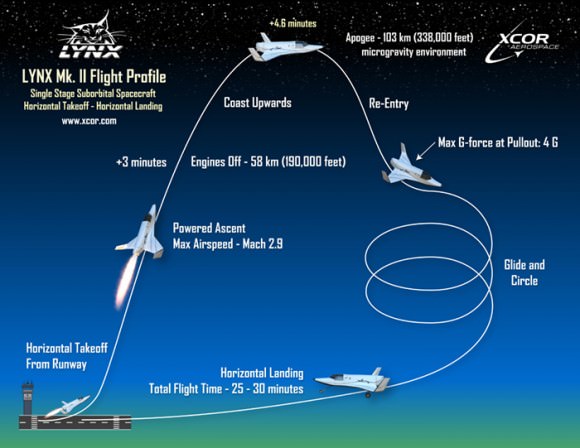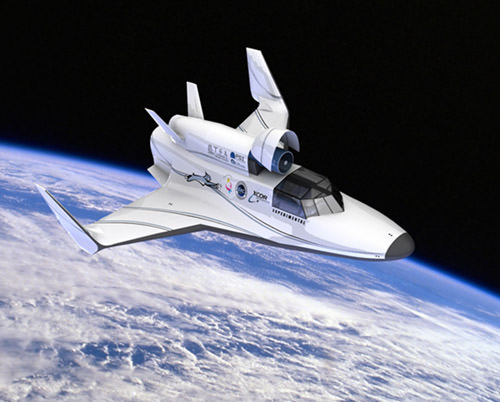[/caption]
Commercial space company XCOR Aerospace has signed a “Memorandum of Understanding” with the Planetary Science Institute, laying the groundwork for flying a human-operated telescope on board XCOR’s Lynx spacecraft. The Atsa Suborbital Observatory is a specially designed telescope for use in suborbital space vehicles, and when used with commercial suborbital vehicles, PSI says it will provide low-cost space-based observations above the contaminating atmosphere of Earth, while avoiding some operational constraints of satellite telescope systems.
“The XCOR vehicle design and capabilities work well for hosting the kind of observing facility we are developing,” said PSI Senior Scientist Faith Vilas, the Atsa Project Scientist.
“NASA has been flying suborbital observatories for decades, on unmanned, disposable rockets. The new manned, reusable commercial platforms will allow us to make repeated observations with a single instrument, but without the need to refurbish it between flights,” said Luke Sollitt, and affiliate scientist with PSI and a co-inventor with Vilas of the Atsa Observatory. “In addition, the short turn-around means we can do many observations or targets.”
Atsa means “eagle” in the Navajo language. The facility is optimized for observing solar system objects near the sun that are difficult to study from orbital observatories such as Hubble and ground-based telescopes.

The Lynx is a two-seat, piloted space transport vehicle, capable of taking humans and payloads on a half-hour suborbital flight to 100 km (330,000 feet) and then return safely to a landing at the takeoff runway, providing 4-6 minutes of weightless flight.
Like an aircraft, Lynx is a horizontal takeoff and horizontal landing vehicle, but instead of a jet or piston engine, Lynx uses its own fully reusable rocket propulsion system to depart a runway and return safely.
The Atsa Observatory will be mounted on the top of the Lynx in an experiment pod. XCOR or PSI did not release the cost per flight, but XCOR’s price for one passenger is $95,000 USD. In contrast, the price for using sounding rockets vary, depending on how high the rocket goes, but some cost as little as $10,000 USD.
“These are natural targets for instruments on suborbital rockets to observe, but a human-tended facility using the kind of reusable launch vehicle offered by XCOR offers significant cost savings,” said Mark Sykes, CEO and Director of PSI, who is also a long-time planetary astronomer and is training to be an Atsa operator.
The Lynx spacecraft will fly to space on a customized flight trajectory and will be capable of precision pointing, allowing the Atsa system with its operator to acquire the desired target and make the planned observations. “We are being approached by many potential customers who are interested in supporting observations of the inner solar system,” Vilas said. “We will also be able to support target of opportunity observations for newly discovered objects and other phenomena.”
“We’re looking forward to flying PSI’s Atsa system on Lynx, it will be a groundbreaking experience. The rapid and flexible operations of the Lynx will enable scientists to pick specific targets of interest and the same day fly multiple tailor made observation missions quickly and inexpensively when they want them to be flown,” said Khaki Rodway McKee, XCOR’s Program Manager.
“We are entering into a new era in the human exploration of space, where private companies like XCOR and PSI will begin to play leading roles in certain areas, beginning with suborbital flight – harkening back to the days of NASA’s Mercury program,” Sykes said.
Andrew Nelson, XCOR’s Chief Operating Officer, said, “Much like the early days of the Internet, mobile communications and social networking revolutions saw new and innovative applications drive commercial multi-billion dollar marketplaces, so we are seeing privately funded efforts like PSI’s Atsa as a key early adopter signaling a robust future for suborbital reusable launch vehicles.”
Source: PSI


i don’t see how 5-minute observing time per day (is that short enough turn-around?) can beat 24/7 operating orbital observatory. the fuel costs must be astronomic! somebody cares to explain?
They’re selling tickets for passengers worth $95,000 USD, so in the end they’ll still be making a profit depending on how much fuel is really used.
Well, that would really depend on how many people are willing to blow that much money for flight that lasts only 30min with just 5 min actually spent in space. That’s probably around 3-5x the yearly salary of the average US citizen and a lot of those corporate fatties that can afford it wouldn’t be able to handle the G’s during the flight.
They would probably have factored in the demand when doing their own internal financial viability reports.
Well, that would really depend on how many people are willing to blow that much money for flight that lasts only 30min with just 5 min actually spent in space. That’s probably around 3-5x the yearly salary of the average US citizen and a lot of those corporate fatties that can afford it wouldn’t be able to handle the G’s during the flight.
Let us hope that (unlike most previous spacecraft, but very much like commercial aircraft) Lynx operating costs are so low that fuel costs *are* a driving factor. The ‘cost of fuel’ has never been a reason for the high cost of spaceflight, because it’s massively overshadowed by other operating overhead.
In any case, Lynx will burn a high grade of…kerosene. Not unlike the SpaceX Falcon-9, the Boeing Saturn-5 first stage, several other rockets, and a less refined grade goes into virtually every jet engine out there.
http://www.parabolicarc.com/2010/03/17/xcor-signs-fuel-agreement-airgas/ (2010-03-17)
What i’ve actually meant was comparison of just the fuel cost for 24 hours of observing time on XCOR to cost of absolutely everything needed for 24 hours of observing time on orbit.
i need 100 thousand usd asap this freaking awesome
Ah. There _is_ a markety for this. I never understood why something that is to Virgin Galactic as NASA is to commercials, at ~ 5 times the cost per seat (and a much less eventful ride), was going to be constructed.